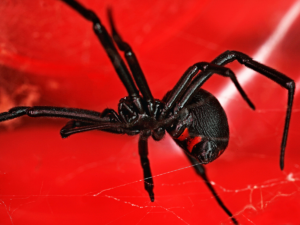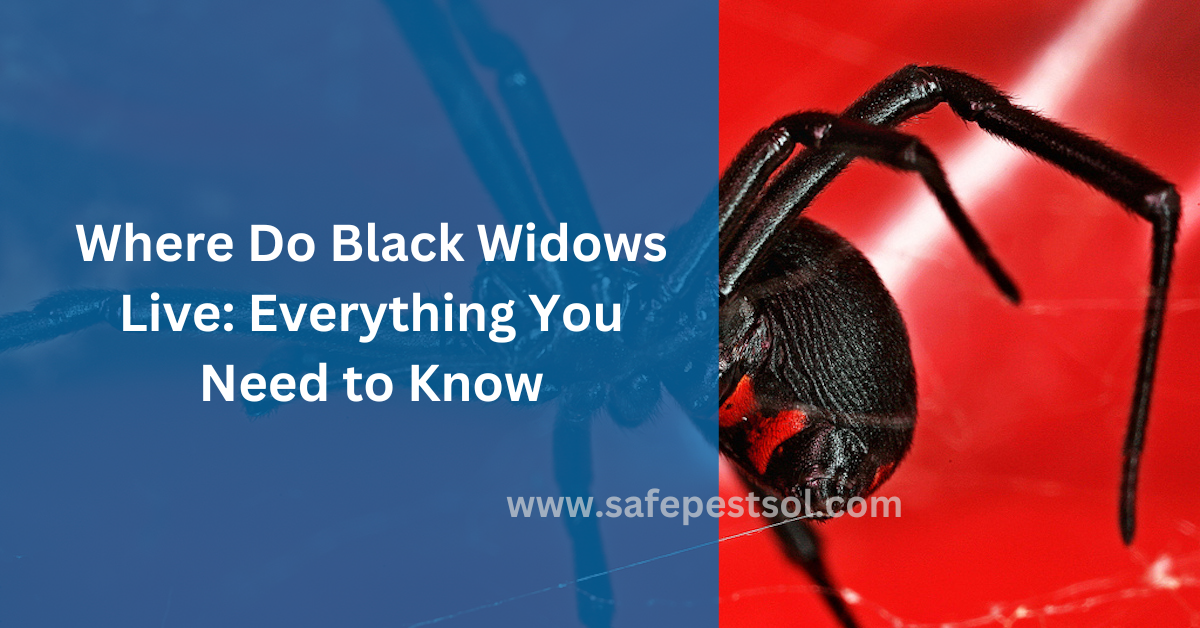Where Do Black Widows Live: Everything You Need to Know
Black widow spiders are among the most fascinating and feared species around the world. Because of their toxic venom and iconic red hourglass appearance on the abdominal side, they are greatly misunderstood.
From quiet home storage areas to natural wood piles, widow spiders live in all kinds of habitats. Here is your comprehensive guide on where these spiders live, what they do, and what you should do if you come across one.

Understanding Black Widow Habitat Behavior
Black widows are members of the comb-footed spider family. They live in dark, hidden places. The female spider is the most poisonous; it has a shiny black body and an hourglass shape. These spiders spin irregular webs close to the ground, often near egg sacs.
Key Habitat Preferences
- They prefer undisturbed, cluttered areas, such as basements and storage rooms.
- In the wild, they prefer living in wood piles, garden sheds, and ground-level areas.
- These spiders eat ants, flies and other insects that are caught in their gluey spider webs.
Where Do Black Widows Live in Homes?
Black widows inside the house prefer to hide in dark, dry, and undisturbed places. These include:
1. Basements: A Common Hiding Place
Black widow spiders usually make their nests in basements because these places are quiet and rarely disturbed. They spin irregular webs in corners or near stored items, especially in dark places.
If you find cobwebs around the ground level, it might be a sign of a possible black widow infestation. These places also attract other insects, which are a source of food for widow spiders.
2. Storage Areas: A Spider Haven
Wall corner storage areas with boxes, old furniture, and other items can harbor the black widow spider. The spiders like tight spaces where they can spin their webs and place egg sacs. Such areas provide them with the perfect combination of shelter and food. Regular cleaning can help cut down on the risk of a pest problem.
3. Corners of Walls and Furniture
Black widows are usually found in the corners of walls and the undersides of furniture. These places are safe and not disturbed, providing females with the perfect place to spin webs and lay eggs. Look for an hourglass marking in a spider web to ensure if there is any infestation. If you accidentally encounter them, you have to look out for the marks of their bites or red spots on your body.
4. Undisturbed Attic Spaces
Attics, just like the basement, are low-traffic zones, which is a perfect spot for spiders to live. They often hide in the corners or crevices of storage areas in the attic. These spiders use strong venom to paralyze their prey and perform exceedingly well in areas in which humans rarely go. Proper maintenance and pest control should be done to avoid an infestation.
Where Do Black Widows Live in Gardens?
Black widow spiders also thrive in gardens. They like to live in the following places:
1. Wood Piles: A Natural Shelter
Black widow spiders often stay in wood piles, which are a natural shelter. They weave their irregular webs between stacked logs, creating a secure place to catch prey and lay egg sacs. If you observe spider webs in these areas, it is best to avoid them because disturbances may likely cause irritation to a black widow spider. Frequent relocation or piling of wood can minimize the risk of infestation.
2. Cluttered Garden Tools and Equipment
The abandoned gardening tools and unused equipment are very likely to become the nesting sites for the widow spiders. The common unnoticed items are the overturned pots, stored hoses, or tarps, which make an ideal location for female spiders. These spots also attract tiny insects, which the spiders feed on. Store your tools properly to deter black widow infestation.
3. Ground-Level Plants and Bushes
Shrubs and bushes are the favorite hiding places for the black widow. These comb-footed spiders create webs close to the soil surface where they easily capture insects. Check for their distinctive red hourglass shape if you suspect there are any spiders. Pruning plants and maintaining them in a neat and clean condition will limit potential pest issues.
4. Debris and Overgrown Areas
Black widow spiders love areas with piles of debris overlooked or overgrown in a garden. These areas provide hiding places, consistent shading, and easy access to prey such as flies and other insects. Maintaining your yard tidy and uncluttered not only deters spiders but also makes your outdoor environment healthier.
Where Do Black Widows Live in Woods?
In the wild, black widow spiders can thrive in the following places;
- Dense Vegetation: Areas with thick undergrowth provide shelter and plenty of prey.
- Wood piles and fallen logs: Ideal nesting and laying of egg sacs
- Natural crevices: The spaces between rocks or hollow trees provide a safe haven for the widows.
What Conditions Do Black Widows Like to Nest In?
Black widows prefer certain conditions for building their spider webs and nests:
- Darkness: They prefer not to be exposed to bright, open spaces.
- Dry places: Humidity can destroy their fragile webs.
- Unvisited places: Fewer human activities ensure a safer nesting place.
- Ample food: The availability of flies, ants, and other insects ensures a food supply.
These conditions can be found both indoors and outdoors, from quiet basements to secluded wood piles.
What to Do If You See a Black Widow
If you are trying to get rid of spider webs or their infestation and you encounter them, following these steps can be helpful:
- Avoid contacting it: You should not touch or try to provoke the spider.
- Identify the spider: Check the abdominal area of the spider for a red hourglass shape. It will help you identify if you are dealing with a black widow spider.
- Call Pest Control: When you realize you have a black widow infestation, seek professional services.
Conclusion
Many of us may not know that black widow spiders are not just unique but quite important for our ecosystem. However, they may bring some dangers for humans as well. But you can avoid any risk by understanding their habitat. You can also minimize facing them by keeping your area safe and managing it well.
FAQs
1. Are black widows dangerous for humans?
Yes, they can be dangerous sometimes. Since these spiders are venomous, they can cause symptoms like muscle cramps, breathing difficulty, and nausea.
2. Is there any way to keep spiders away from my home?
There are many easy ways to do it. You can start by cleaning your storage and basement areas. You can also try removing debris from cluttered areas. But if necessary, it is preferred to call experts.
3. Where are black widows most commonly found?
They are common in North America, particularly in dark brown areas such as wood piles, gardens, and storage areas.
If You Encounter Any Spider, Just Call Safe Pest Sol!
While there are several ways to deal with spider infestation, the most important one is to call experts. If you are facing any spider infestation at your place, just call for our pest control services and let us handle it efficiently.

